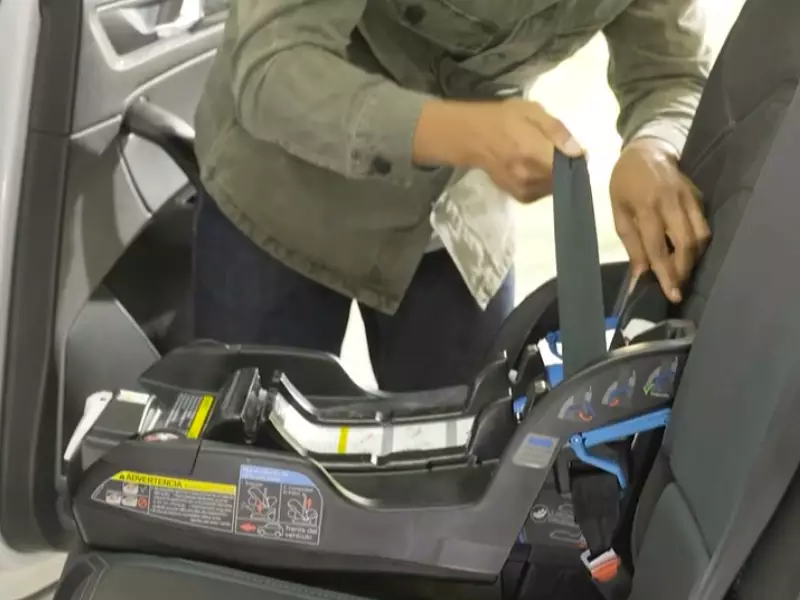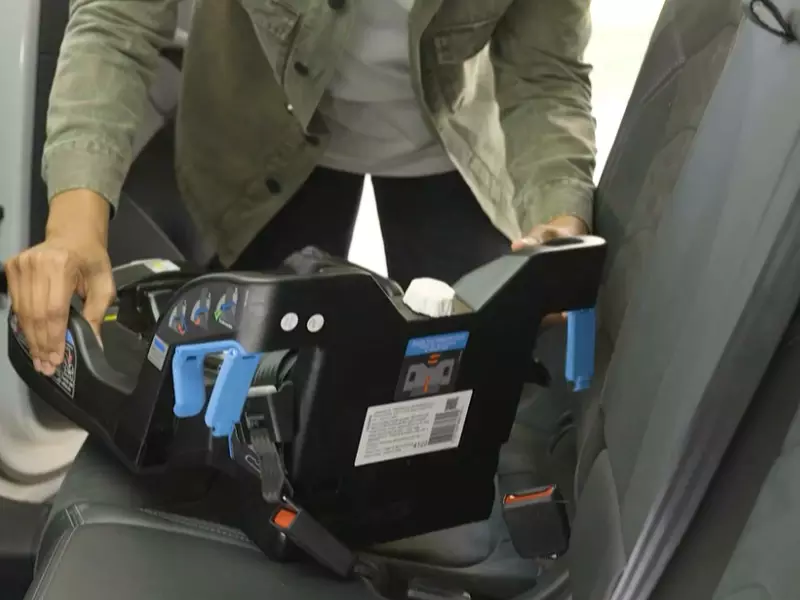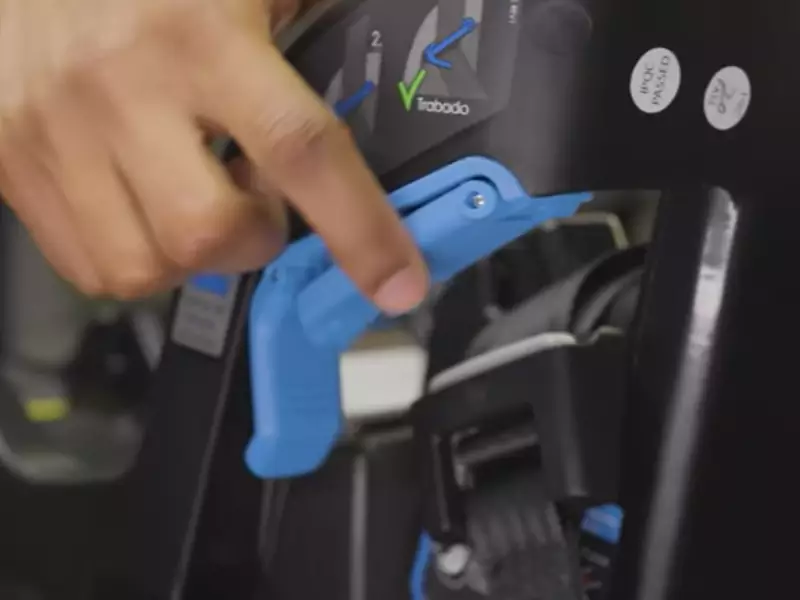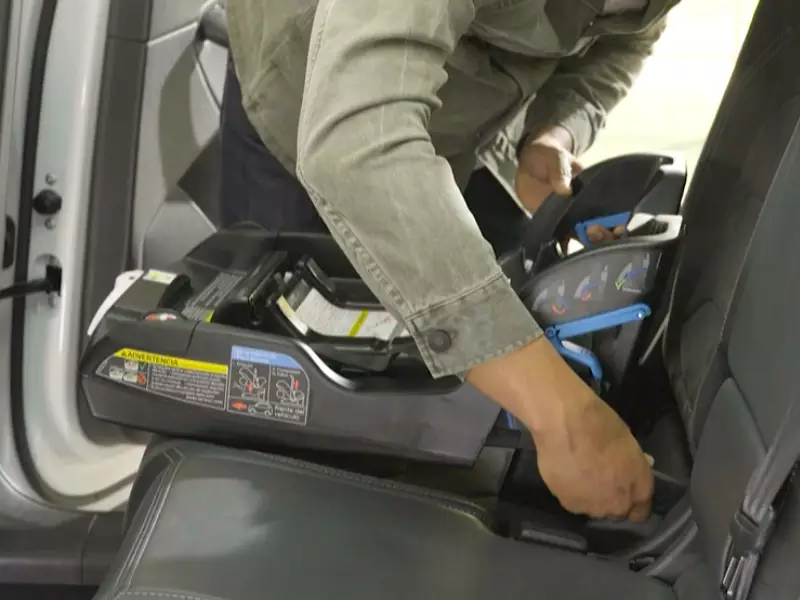To install a car seat with a latch system, secure the lower anchors to the vehicle’s anchors and tighten the straps until the seat is snug. Installing a car seat with a latch system is an essential safety measure for parents and caregivers.
The latch system, short for Lower Anchors and Tethers for Children, provides a simplified and secure method for securing car seats. By correctly installing a car seat using the lower anchors and tether, you can reduce the risk of injury to your child in the event of a sudden stop or collision.
We will guide you through the step-by-step process of installing a car seat with a latch system, ensuring the safety of your little one during car rides.
Choosing The Right Car Seat For Your Child
When it comes to keeping our little ones safe on the road, choosing the right car seat is of utmost importance. With the variety of options available, it can be overwhelming to determine which one is best suited for your child. However, by considering a few key factors, understanding the different types of car seats, and paying attention to age and weight restrictions, you can ensure that you make the best choice for your child’s safety.

Factors to Consider When Selecting a Car Seat
When selecting a car seat, there are several factors to take into account:
- Age and Size: It is important to choose a car seat that is suitable for your child’s age and size. Car seats are typically classified into different stages based on your child’s age group – infant, toddler, and booster. Each stage has specific features designed to provide optimal safety and comfort for your child at different developmental stages. Make sure to choose a seat that is appropriate for your child’s age and weight.
- In-Vehicle Space: Consider the available space in your vehicle when selecting a car seat. Some car seats may require more space compared to others, especially if you have a small car or multiple children. Keep in mind the size and dimensions of the car seat and check if it can accommodate your vehicle’s space constraints.
- Installation Ease: Look for a car seat that is easy to install and secure properly. An incorrectly installed car seat can compromise your child’s safety. Some car seats come with advanced installation systems, such as the LATCH (Lower Anchors and Tethers for Children) system, which provides a more secure and convenient installation process.
- Budget: Car seats come in a wide range of prices, so it’s important to consider your budget. Remember that a higher price doesn’t always guarantee better safety. Look for a car seat that meets the necessary safety standards within your price range.
- Safety Features: Pay attention to the safety features offered by the car seat. This may include side-impact protection, energy-absorbing foam, adjustable harnesses, and reinforced frames. The more safety features a car seat has, the better protected your child will be in the event of an accident.
Understanding Different Types of Car Seats
There are three main types of car seats: infant car seats, convertible car seats, and booster seats.
| Type of Car Seat | Age Range | Weight Range |
|---|---|---|
| Infant Car Seat | 0-1 year | Up to 35 pounds |
| Convertible Car Seat | 1-3 years | Up to 40-65 pounds |
| Booster Seat | 4-12 years | 40-120 pounds |
Infant car seats are rear-facing and provide a snug fit for newborns and infants. They usually have a detachable carrier and a base that stays in the car. Convertible car seats can be used in both rear-facing and forward-facing positions, allowing them to accommodate different stages of your child’s growth. Booster seats are designed to raise your child up so that the seat belt fits properly across their chest and lap.

Importance of Age and Weight Restrictions
Adhering to the age and weight restrictions specified by the car seat manufacturer is crucial for your child’s safety. These restrictions are put in place to ensure that the car seat can effectively protect your child in the event of a crash. Using a car seat that is not suitable for your child’s age and weight can result in inadequate protection.
Always refer to the car seat’s user manual and labels for the specific age and weight requirements. It is important to transition to the next stage car seat as your child grows, as each stage provides the necessary safety features and support appropriate for their developmental needs.
By considering the factors mentioned above, understanding the different types of car seats available, and following the age and weight restrictions, you can confidently choose the most appropriate car seat for your child. Prioritize their safety on the road, ensuring their protection in any unforeseen circumstances.
Understanding The Latch System
Installing a car seat is one of the most important tasks for parents and caregivers. Ensuring that the car seat is properly installed is crucial for the safety of the child. One popular method of installing car seats is by using the LATCH (Lower Anchors and Tethers for Children) system.
What is the LATCH System?
The LATCH system is a standardized method for installing car seats in vehicles, designed to make the installation process safer and easier. LATCH consists of two lower anchors and an additional top tether in the vehicle, which directly attach to the car seat.
How does the LATCH System work?
The LATCH system eliminates the need to use the vehicle’s seat belt to secure the car seat. Instead, it uses a set of lower anchors located in the vehicle’s seat crease. The car seat itself has corresponding connectors that easily attach to the lower anchors.
Additionally, the LATCH system utilizes a top tether strap that provides an extra layer of stability. The top tether is attached to the car seat and anchored to a designated tether anchor located in the vehicle. This prevents excessive movement of the car seat during a collision or sudden stop.
Benefits of using the LATCH System
Using the LATCH system offers several advantages over using the seat belt method. Here are some key benefits:
- Ease of use: The LATCH system simplifies the installation process, making it easier for parents and caregivers to install the car seat correctly.
- Increased safety: The LATCH system provides a more secure installation, reducing the risk of the car seat becoming loose or shifting in the event of a crash.
- Consistency: Since the LATCH system is standardized across vehicles, it ensures a consistent method of installing car seats, regardless of the make or model of the vehicle.
- Versatility: Most car seats and vehicles manufactured after September 2002 are equipped with the LATCH system, allowing for compatibility between different brands and models.
By understanding the LATCH system and how it works, parents and caregivers can ensure a safer and more secure car seat installation, providing peace of mind during every journey.

Preparing Your Car For Car Seat Installation
Before installing a car seat with the LATCH system, it is crucial to properly prepare your car to ensure a secure and safe installation. Taking these steps will help you create a stable foundation, providing the best protection for your little one.
Checking your car’s LATCH compatibility
The first step in preparing your car for a car seat installation is to check if your vehicle is equipped with the LATCH system. LATCH stands for Lower Anchors and Tethers for Children and is designed to simplify the car seat installation process. To ensure your car is LATCH compatible, consult your vehicle’s owner’s manual or look for the LATCH symbol on the seat upholstery or between the seat cushions. If your car is not LATCH compatible, you can still install the car seat using the seatbelt method.
Clearing out and cleaning the car seat area
Next, you’ll want to clear out any clutter or debris from the area where the car seat will be installed. Remove any loose items, such as toys or food wrappers, as they can become hazardous in the event of an accident. Additionally, taking the time to clean the seat area will help ensure a secure installation. Vacuum any crumbs or dirt, as this will prevent the car seat from shifting or sliding during transit.
Adjusting the car seat position for optimal safety
Proper positioning of the car seat is essential for optimal safety. Start by adjusting the seat to the appropriate recline angle, as indicated in the car seat’s instruction manual. This angle is crucial for newborns and infants who lack head and neck control. Once the angle is set, ensure that the car seat is centered on the vehicle’s seat, with equal spacing on either side.
It is also important to adjust the harness straps to fit securely around your child. Make sure the straps lie flat without any twists and that they are threaded through the correct slots on the car seat. Additionally, ensure that the chest clip is positioned at armpit level to keep the shoulder straps properly in place.
Finally, check for any movement or excessive wiggle room by firmly gripping the car seat where it is installed and attempting to move it side to side and front to back. The car seat should not move more than an inch in any direction. If there is excessive movement, you may need to further tighten the LATCH straps or use the seatbelt method for installation.
By following these steps to prepare your car for car seat installation, you can be confident that your little one will be protected on every journey. Remember to consult both your vehicle’s owner’s manual and the car seat’s instruction manual for detailed instructions specific to your make and model.

Installing The Car Seat Base
Understanding the Car Seat Base Components
Before you begin installing the car seat base with the LATCH system, it’s important to familiarize yourself with the various components. This knowledge will help ensure a smooth installation process and provide optimal safety for your little one.
The car seat base typically consists of the following components:
| Component | Description |
|---|---|
| Base | The main portion of the car seat that attaches to your vehicle. |
| Lower Anchors | Metal attachments located in the backseat of your vehicle that securely connect the car seat base to the vehicle. |
| Lower Anchor Connectors | Straps or hooks on the car seat base that attach to the lower anchors. |
| Level Indicator | A visual guide on the car seat base that helps you ensure that it is installed at the correct angle. |
Step-by-Step Guide for Installing the Car Seat Base with LATCH
Installing the car seat base with the LATCH system is a straightforward process. Follow these step-by-step instructions to ensure a proper and secure installation:
- Locate the lower anchors in your vehicle’s backseat. They are typically found between the seat cushions.
- Attach the lower anchor connectors on the car seat base to the lower anchors in your vehicle. Make sure the connectors are securely latched onto the anchors.
- Apply downward pressure on the car seat base while pulling the lower anchor straps tight. This will ensure a snug and secure fit.
- Check the level indicator on the car seat base. It should be within the acceptable range to ensure the correct installation angle.
- Double-check that the car seat base is securely installed by giving it a firm shake. It should not move more than an inch in any direction.
Common Mistakes to Avoid During Installation
While installing the car seat base with the LATCH system is relatively simple, there are a few common mistakes to avoid to ensure the utmost safety for your child. Be mindful of the following:
- Not properly attaching the lower anchor connectors to the lower anchors can result in an insecure installation.
- Improperly tightening the lower anchor straps may lead to a loose and unsafe fit.
- Incorrectly interpreting the level indicator may result in an improper installation angle.
- Failure to double-check the tightness and stability of the installation could compromise your child’s safety on the road.
By understanding the car seat base components, following the step-by-step installation guide, and avoiding common mistakes, you can feel confident in installing your car seat with the LATCH system correctly. Ensure the safety of your child by taking the time to install the car seat base properly, providing peace of mind on your journeys together.

Securing The Car Seat With Latch
Attaching the car seat to the base using LATCH anchors
When it comes to securing your car seat, the LATCH system provides an easy and reliable way to keep your little one safe and secure during every journey. LATCH stands for Lower Anchors and Tethers for Children, and it offers a simple and secure way to install your car seat without using the vehicle’s seat belt.
Attaching the car seat to the base using LATCH anchors is a straightforward process. Most car seats come with built-in LATCH connectors, which are metal hooks or bars located at the base of the seat. These connectors easily attach to the LATCH anchors in your vehicle, usually located between the seat cushions.
To install the car seat using the LATCH system, follow these easy steps:
- Read the car seat and vehicle owner’s manual to locate the LATCH anchors and understand any specific instructions or requirements.
- Position the car seat securely on the vehicle seat, ensuring that it is facing the correct direction according to the car seat’s guidelines.
- Locate the LATCH connectors at the base of the car seat.
- Insert the LATCH connectors into the LATCH anchors in the vehicle. Ensure that you hear a “click” or visual indicator that the connectors are properly locked into place.
- Double-check the tightness of the LATCH connectors by gently pulling on them. The car seat should not move more than one inch in any direction.
Adjusting and tightening the LATCH straps for a secure fit
Once you have attached the car seat to the base using the LATCH anchors, it’s important to adjust and tighten the LATCH straps properly. This will ensure that the car seat is securely in place and will provide maximum protection in the event of a collision.
Follow these steps to adjust and tighten the LATCH straps:
- Find the LATCH strap adjuster, usually located near the base of the car seat.
- Loosen the LATCH strap by pulling on the adjuster strap.
- Position the car seat firmly against the vehicle seatback and base, ensuring it is level and not leaning to one side.
- Tighten the LATCH strap by pulling on the adjuster strap until the car seat is snug and does not move more than one inch in any direction.
- Double-check the tightness of the LATCH straps by gently tugging on them. The car seat should be securely attached and not shift or rotate.
Checking for proper installation and stability
After securing the car seat with the LATCH system, it’s crucial to check for proper installation and stability before hitting the road. This quick inspection ensures that your child will be safe and protected throughout the journey.
Here are a few essential steps to check for proper installation and stability:
- Visually inspect the car seat to ensure that it is level, with no visible gaps or twists in the straps.
- Check the LATCH anchors and connectors to ensure they are securely latched and locked in place.
- Gently tug on the car seat from different angles to confirm that it does not move more than one inch in any direction.
- Verify that the car seat is installed according to the manufacturer’s instructions and recommendations.
- Double-check the tightness of the LATCH straps by giving them a final firm tug.
By following these steps and checking for proper installation and stability, you can rest assured that your car seat is securely installed using the LATCH system. Remember to consult both the car seat and vehicle owner’s manual for specific instructions and guidelines to ensure the utmost safety for your child.
Frequently Asked Questions For How To Install Car Seat With Latch System
How Do You Install A Car Seat Base Latch?
To install a car seat base using the LATCH system, first locate the anchors in your vehicle’s back seat. Attach the LATCH connectors to these anchors. Then, tighten the straps to secure the base. Ensure the seat is stable by pushing and pulling on it.
Double-check the installation with the car seat manual.
How Do You Install A Forward Facing Car Seat With A Latch?
To install a forward-facing car seat with LATCH, locate the lower anchors in your vehicle, attach the lower anchor connectors from the car seat, and tighten them until secure. Then, connect the top tether anchor and tighten it. Finally, check for a tight fit and ensure the seat is properly secured.
Should You Install Car Seat With Latch Or Seat Belt?
Install the car seat with either LATCH or seat belt. Both options are safe when properly used. Choose the method that allows for a secure and tight fit in your specific vehicle.
Can You Install A Latch System In A Car?
Yes, you can install a LATCH system in a car. The LATCH system, also known as Lower Anchors and Tethers for Children, provides a way to secure a child’s car seat without using seat belts. It’s important to follow the car seat and vehicle manufacturer’s instructions for proper installation.
Conclusion
Installing a car seat with the LATCH system is an essential step in ensuring your child’s safety during car rides. By following the proper installation process, you can have peace of mind knowing that your little one is secure. With the step-by-step guide provided in this blog post, you now have the knowledge to confidently install your car seat.
Remember to always refer to the car seat manual for specific instructions and seek professional assistance if needed. Keep your child safe and happy on the road!
